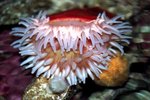The Scyphozoa class encompasses more than 200 jellyfish species worldwide. While many prefer to remain close to shore, Scyphozoans in the Atolla genus have adapted to life deep in oceans where sunlight never reaches. All six Atolla species rely on bioluminescence -- light they produce themselves -- but the Atolla wyvillei uses the light in a defensive strategy that none of the other species employs.
Habitat
Wyvellei jellyfish live in deep oceans throughout the world, from the Arctic to the Antarctic. They've also been found in the North Atlantic and Pacific, the Gulf of Mexico and waters around New Zealand. Their typical habitat ranges from 3,280 feet below the surface to more than 13,000 feet below the surface, where temperatures average between 29 degrees Fahrenheit and 2 degrees below zero Fahrenheit.
Size
Atolla wyvilleis’ bodies, or bells, measure as little as 6/10 of an inch across to 8 inches across. A wyvillei usually has 22 marginal tentacles around the rim of the body and one hypertrophied tentacle, which might be 1.5 times to 36 times longer than the bell's diameter.
Bioluminescence and Defense
Like many deep-sea denizens, Atolla wyvillei produce their own light, called bioluminescence. They use this ability differently than other animals, including the other five Atolla species, though. When a predator approaches, Atolla wyvillei emit a flashing blue light that attracts other, larger predators to gobble up the threat. Of all colors, blue reaches the greatest distance underwater. This defensive strategy has earned wyvillei the nickname "alarm jellyfish."
Hypertrophied Tentacles
Scientists are still studying how Atolla wyvillei use their hypertrophied tentacles, which coil and retract into the jellyfish’s bell. One theory suggests these tentacles passively trap food such as crustaceans and organic matter that float by in ocean currents. Scientists have speculated that the tentacles help in sexual reproduction by reaching out in search of potential mates.
Reproduction
Atolla wyvillei can reproduce asexually and sexually. Researchers have speculated that the jellyfish attach via their hypertrophied tentacles to enable the males to fertilize the females’ eggs. Like many other members of the Scyphozoa class, Atolla wyvillei can develop into polyps, asexually producing buds that grow into larvae.
References
- AquaViews Online Scuba Magazine: Creatures of the Deep: Atolla Jellyfish
- Encyclopedia of Life: Atolla wyvillei: Detail
- Monterey Bay Aquarium Research Institute: The Form and Function of the Hypertrophied Tentacle of Deep-Sea Jelly Atolla spp.; Alexis Walker
- World Register of Marine Species: WoRMS Taxon Details: Atolla wyvillei -- Haeckel, 1880
- NBC News: Science: Bioluminescence Lights Up Creatures of the Oceans
- The University of Michigan Museum of Zoology: Animal Diversity Web: Scyphozoa
- The University of Michigan Museum of Zoology: Animal Diversity Web: Atolla wyvillei




